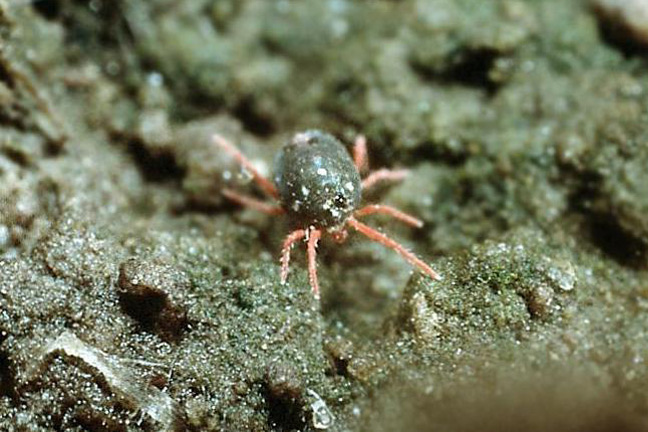
Agricultural News
Dr. Tom Royer Explains How to Deal with Winter Grain Mite Infestation
Tue, 29 Jan 2013 11:09:32 CST

Writing in the online Extension newsletter, Dr. Tom Royer, Extension entomologist, takes a look at winter grain mite infestation.
I have received several calls about winter grain mite (WGM) infestations in wheat. I thought I would review its description, and some control options. Much of this information was published last year, but I have added some additional information regarding which insecticides are effective.
Description: This mite is small (about the 1 mm long) with a dark blue to black body and 4 pair of orange-red legs. It also has a small reddish spot on the top of its abdomen that can be seen under magnification. The eggs of WGM are kidney-shaped, and change from clear, to yellow to reddish-orange after several days. They are laid on leaf blades and stems or the roots near the crown. Besides wheat, many grasses serve as host plants, including barley, oats, ryegrass and fescue.
Life Cycle: Winter grain mites complete two generations per year, the first beginning in fall from over-summering eggs and the second from eggs laid in January/February. In all cases, adult mites are females, all of which are capable of laying eggs. The first generation peaked in December/January and the second will peak in March/April. Newly-hatched mites molt 3 times before becoming adults, and take up to 60 days to mature. Adults can live for up to 40 days.
Winter grain mites over-summer as eggs. They get their name because they like grains and grasses, and they really don't like warm weather. They are most active when temperatures are between 40O and 70O F. Freezing conditions and/or snow cover don't really affect them.
Nature of Damage and Scouting: Winter grain mites feed by piercing plant cells in the leaf, which results in "stippling". As injury continues, the leaves take on a characteristic grayish or silvery cast and could be mistaken for injury due to herbicide. Winter grain mites are more likely to cause injury in wheat if it is already stressed due to lack of moisture or nutrients. Winter grain mites are light sensitive and tend to avoid bright, sunny days and windy days, so adjust your scouting accordingly. On still, cloudy days or early morning/evening, they will be active on the plants and can easily be counted. On sunny or windy days, they will be found under the soil surface (up to a couple of inches) or massed under dirt clods.
Control: Winter grain mites are more common in fields of continuous wheat, so crop rotation will help break the cycle. In addition, they are reported to be more numerous in fields that have a minimum amount of tillage applied to them. Winter grain mites do not typically cause excessive injury unless present in excessive numbers and plant growing conditions do not sustain rapid growth of wheat foliage, such as when an infestation is coupled with nitrogen deficiency. While WGM pests can damage wheat even under normal growing conditions, it takes large numbers to justify an insecticide application for their control. There is no established threshold for WGM; my best "guestimation" is to treat when injury symptoms are visible and mite numbers exceed 10 per plant.
There are few insecticides that include WGM on the label, but they can probably be controlled with other products registered for use in wheat. Work conducted by Dr. Gerald Wilde at Kansas State evaluated several insecticides for control of winter grain mites. Of those actually registered for winter grain mite, the insecticides dimethoate (Dimethoate and other generics) and chlorpyrifos (Lorsban and other generics) were effective. In addition, products containing lambda cyhalhthrin (Karate and generics) should also be effective, even if they are not specifically listed on the label.
Under section 2 (ee) regulations of the Federal Insecticide, Fungicide and Rodenticide Act (FIFRA), a product that is labeled for use in a crop can be used to control a pest that is not specifically on the label. However, the rate used must fall within the range of labeled rates for that crop, and if the pest is not on the label, the user assumes all responsibility for the effectiveness of the application. Check CR-7194, "Management of Insect and Mite Pests in Small Grains" for registered insecticides, application rates, and grazing/harvest waiting periods. It can be obtained from any County Extension Office, or found at the OSU Extra Website at http://pods.dasnr.okstate.edu/docushare/dsweb/Get/Document-2601/CR-7194web2008.pdf
WebReadyTM Powered by WireReady® NSI
Top Agricultural News
More Headlines...



















